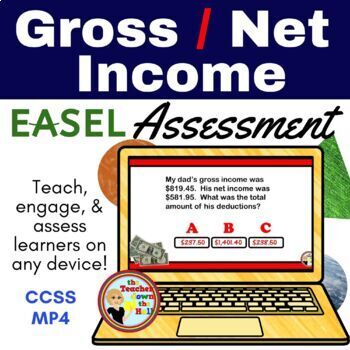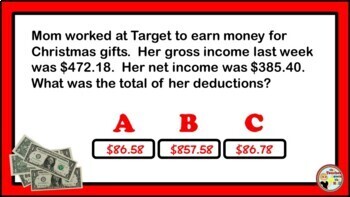Gross and Net Income Easel Assessment
The Teacher down the Hall
3.3k Followers
Grade Levels
5th - 6th, Homeschool
Subjects
Resource Type
Standards
CCSSMP4
Formats Included
- Internet Activities
- Easel Assessment
Made-for-Easel resource
This is an interactive, online-only experience that cannot be printed. Learn more.
Pages
20 pages
The Teacher down the Hall
3.3k Followers
Compatible with Digital Devices
The Teacher-Author has indicated that this resource can be used for device-based learning.
Description
Need a fun way to introduce or assess your students' knowledge of Gross and Net Income? They'll read 16 different financial scenarios and determine the net income or the total amount of deductions when given the gross income. Great for instruction, centers, and even formative assessments!
BENEFITS OF THIS RESOURCE:
No Prep
Works on any device
Self-grading
Immediate Feedback
Detailed DATA!
Great for Distance Learning
*****************************************************************************
Other great resources
Follow The Teacher Down the Hall for notifications of new products & special sales!
*****************************************************************************
Total Pages
20 pages
Answer Key
Included
Teaching Duration
30 minutes
Easel is an interactive, online-only experience that cannot be printed.
How to assign this Easel resource

Assign it to Google Classroom without leaving TPT, or share a direct link to it.

Students log in with their Google email, or use any email address to create a new account.

Easel works right in the browser on a tablet or computer. No downloading or installing needed.
Report this resource to TPT
Reported resources will be reviewed by our team. Report this resource to let us know if this resource violates TPT’s content guidelines.
Standards
to see state-specific standards (only available in the US).
CCSSMP4
Model with mathematics. Mathematically proficient students can apply the mathematics they know to solve problems arising in everyday life, society, and the workplace. In early grades, this might be as simple as writing an addition equation to describe a situation. In middle grades, a student might apply proportional reasoning to plan a school event or analyze a problem in the community. By high school, a student might use geometry to solve a design problem or use a function to describe how one quantity of interest depends on another. Mathematically proficient students who can apply what they know are comfortable making assumptions and approximations to simplify a complicated situation, realizing that these may need revision later. They are able to identify important quantities in a practical situation and map their relationships using such tools as diagrams, two-way tables, graphs, flowcharts and formulas. They can analyze those relationships mathematically to draw conclusions. They routinely interpret their mathematical results in the context of the situation and reflect on whether the results make sense, possibly improving the model if it has not served its purpose.





